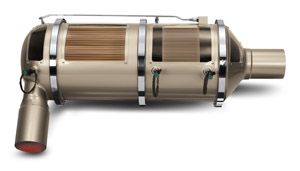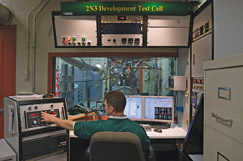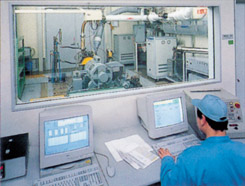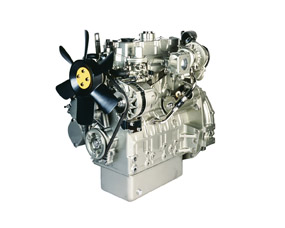
Ready for Tier 4
By Pat Bolen*
ProductsWith the continued focus of governments to meet the public demand for tougher environmental standards...
With the continued focus of governments to meet the public demand for tougher environmental standards, manufacturers of non-road equipment engines have new standards to meet, with the introduction of the Environmental Protection Agency (EPA) Tier 4 emission standards being phased in between 2008 and 2014. Canadian Rental Service magazine spoke to representatives of several companies to get their thoughts on how the new standards will affect the industry.
 |
| A cutaway of John Deere's Diesel Particulate Filter (DPF) which will be one of the technologies used to meet the Tier 4 emission standards. Photo Courtesy Of John Deere Power Systems. |
J.P. Ouellette, sales and marketing manager for the Industrial Engine Division of Kubota Canada, says the company will have no problems meeting the new standards, but every engine size and type brings a different set of challenges. “With each power band, you use different technology so you could have a combination in some or very little in others. For example, over 75 horsepower, you’re probably going to be using a combination of exhaust gas recirculators and diesel particulate filters, versus lower horsepower which seems to be able to meet the standards with less technology being added to it.”
Ouellette says most of what will be used to help meet the standards is existing technology. “We’re very fortunate at Kubota to have the ability to engineer and redesign the engine itself.” Despite the tougher standards, Ouellette says there will not be a loss in power, but prices will probably rise. “The technology will demand some sort of cost compensation… it depends how the supply chain figures that out. If all the manufacturers go to a certain technology and it becomes readily available, then it becomes cheaper because of the volume, and that will be reflected.”
Despite claims that Tier 4 regulations will mean virtually zero emissions, Ouellette says, “I don’t think you should be misled by anyone who claims zero emissions. If you have explosions occurring in an engine, you have emissions. Zero emission is impossible. You can take the emission, hide it, change it and pipe it, but you’re going to have something. The greening of our society and the constant cleaning of the engines that we use is probably the one thing, looking at the future of the planet, that could very well save it.”
 |
| Many of John Deere Power System’s engines under 100 horsepower (75kW) are EPA Tier 3, Interim Tier 4 and European Union (EU) Stage 3. Photo Courtesy Of John Deere Power Systems. |
Joe Suchecki is director of public relations with the Engine Manufacturers Association (EMA) and says the members of the EMA feel the emission standards timeline allows enough time to develop the technology in order to meet the regulations. “We aren’t anticipating any problems in the timetable to meeting those standards.”
Suchecki says that manufacturers were expecting a new set of standards and worked closely with the EPA to develop them. “We were able to provide information to the EPA on what’s feasible and what’s not… so they had sound information about when we could implement those standards.” He adds that while the EPA originally wanted the standards to be brought in sooner, the EMA explained what is involved in developing the technology. “The fact that there are so many configurations and types of off-road equipment means that you just couldn’t do it sooner.”
Suchecki says the difference between Tier 4 and the previous standards is that the newest regulations will require after-treatment on engines. “Up until now, with Tier 3 standards, the engine manufacturers were able to make changes with the engine itself. But with Tier 4, essentially we kind of reached the limit of how low we can get the emissions from the engines.”
What is required for the Tier 4, according to Suchecki, are muffler type applications to the exhaust system for the treatment of particulate matter and nitrogen oxide. Suchecki says the technology for the removal of particulate matter is already well developed for on-road equipment and it is just a matter of fitting it to off-road equipment. “That technology is pretty well known. As long as we have the low sulphur fuel, it’s just a matter of designing that into the equipment somewhere.”
 |
| Kubota’s emission test room. Photo Courtesy Of Kubota Canada. |
To reduce nitrogen oxide, Suchecki says the best solution is Selective Catalytic Reduction (SCR). “If the industry takes that approach, in addition to having a filter, you’re going to also have to have a tank for urea, which is a reductant that is used to reduce the nitrogen oxide levels. The SCR is a little bit more problematic and the decision has not been made as to which way to go for off-road equipment. Perhaps there will be some breakthrough between now and when we have to implement the off-road rules, so maybe there will be a better solution.”
Suchecki says the Tier 4 standards will take emissions close to zero, especially in particulate matter. “Ninety percent of the emission reductions over the years have been achieved with fuel and engine design changes. That was simple and fairly cost effective. By the time Tier 4 comes around, we’re down to 99 percent emission reductions. Beyond that, it will just get very difficult to get the last amounts out and considerably more expensive as well.”
Engines will still be designed to meet the needs of customers. “We need to meet customer demand first, so I’m sure all the machinery will be designed around that. It has to be able to do the job it was designed for,” says Suchecki.
While there are no estimates yet for any price changes in non-road equipment due to the new standards, according to Suchecki, “It’s safe to say that if we’re putting on this extra equipment, the cost will be higher.” He adds that engines at the top and bottom size present the most challenges, since manufacturers have a lot of experience with mid-range engines. For small engines, it is a matter of cost in relation to the engine. “There is concern about both ends… for getting the technology developed.”
Martin Connolly, CEO of International Power Systems, a distributor for Honda industrial engines for Ontario says there have not been many requests from the field for a reduction in emissions for its equipment being used in urban areas. “I suspect it’s the strength of the brand. I think there’s an acknowledgment in the market that because it’s Honda, they expect them to be at the front of technological development.”
But Connolly notes the company is getting more requests for noise reductions, “which seems to be more and more important, particularly in the residential areas.” While Connolly says there are more regulations coming for equipment noise, he feels it is being driven at a municipal level. “I don’t think there is much acknowledgment at the provincial or federal level.”
Tim Cresswell is product marketing manager for Perkins Engine Company and says the ramifications of the forthcoming levels of emissions legislation are significant. “We will certainly see introductions of enhanced technologies, both internal and external to the engine, to reduce nitrogen oxide and particulate matter. Initially, we expect to see the introduction of systems such as Diesel Oxidation Catalysts (DOC), depending on horsepower band.”
With the emissions box becoming ever smaller, Perkins is looking to provide tailored emissions solutions to Original Equipment Manufacturers (OEMs) through a combination of technologies including next generation turbocharging, advanced electronics, advanced fuel systems and particulate after-treatment systems.
 |
| Perkins 400D engine. Photo Courtesy Of Perkins Engine Company. |
Cresswell says, “It is the advent of such after-treatment systems that will be the most evident and physically challenging in terms of engine packaging. Diesel particulate filters and the accompanying filter regeneration equipment will add to the overall installation volume. A typical particulate filter assembly, though hugely efficient, potentially carries a significant weight and size penalty, causing a rethink for OEMs when it comes to equipment design.”
Doug Laudick, manager of product planning at John Deere Power Systems, explains how the company is meeting the new standards. “John Deere will meet all deadlines, but there will be numerous opportunities encountered in order to meet Interim Tier 4 deadlines. These opportunities include the adoption of various technologies not currently used in off-highway applications. The EPA and EU tiered regulations provide for increasingly stringent emissions. The Interim Tier 4/Stage 3 B certified engines John Deere will supply have lower emissions than previous generations.”
The company says it will build on the technologies adopted for Tier 3 including variable geometry turbochargers (VGT), cooled exhaust gas recirculation (EGR), air-to-air after-cooling, improved higher pressure fuel systems, four valve cylinder heads and electronic engine controls. For engines greater than 174 horsepower, John Deere will leverage its Tier 3 experience with these technologies and add a DOC and Diesel Particulate Filter (DPF), along with a regeneration management system, to achieve Interim Tier 4.
Laudick continues, “The packaging of Interim Tier 4 solutions into applications also represents a significant engineering challenge. Increasingly stringent emissions regulations require the adoption of increasingly sophisticated technologies to achieve compliance.” -end-
*Pat Bolan is a freelance writer based in Exeter, Ontario.
Print this page